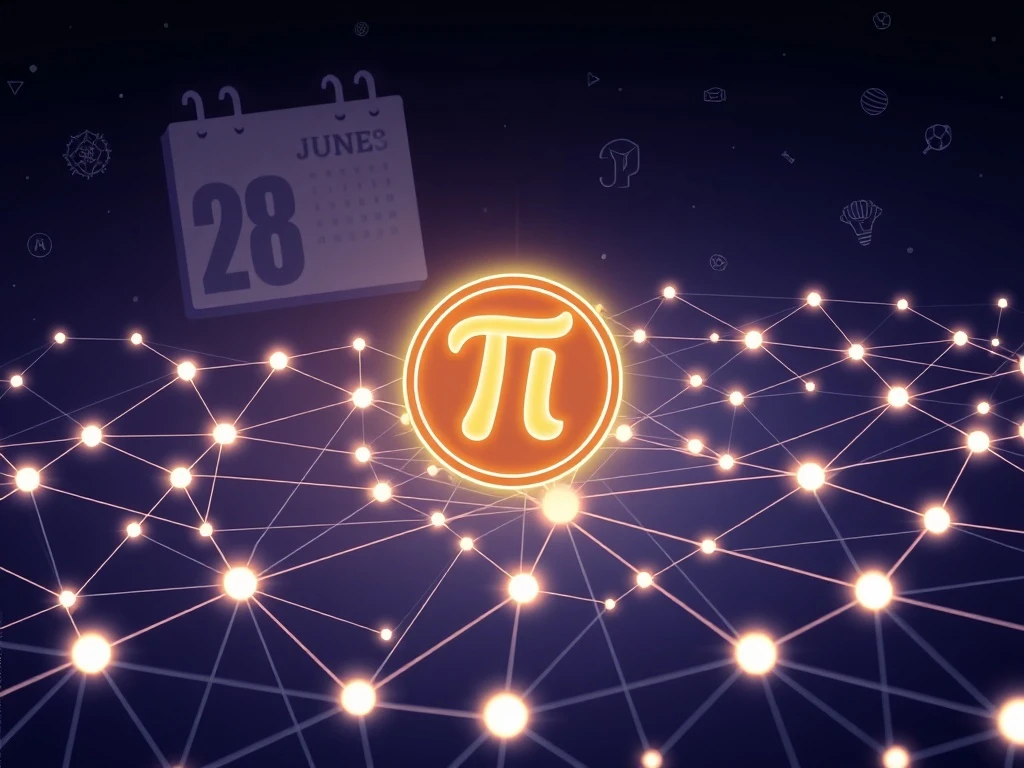Pi Network’s Pivotal Pi2Day: Unlocking the Future of Crypto Utility

The cryptocurrency world is buzzing with anticipation as June 28th approaches, marking another significant Pi2Day for the Pi Network community. This annual event has historically been a moment of reflection and a springboard for major announcements, and 2025 is shaping up to be no different. For pioneers who have been diligently mining Pi on their phones, this day could signal profound shifts, especially now that the Pi Mainnet is officially live. Will this year’s Pi2Day truly change the network forever? Let’s dive into what you need to know.
Pi Network’s Journey: From Mobile Mining to Open Mainnet
Every year on June 28th, the Pi Network celebrates Pi2Day, a mid-year check-in that complements the original Pi Day on March 14th. This clever nod to mathematics (3.14 for Pi Day, 6.28 for Pi2Day) has evolved into a critical juncture for the Pi community. Since 2023, the core team has used this day to showcase progress and rally users behind major initiatives.
For instance, Pi2Day 2024 featured a “Progress to Open Network” campaign. Millions of users, known as “pioneers,” completed Know Your Customer (KYC) verification and tested new applications in preparation for the mainnet launch. This initiative alone attracted approximately 4.5 million participants, highlighting the growing activity within the Pi community.
Fast forward to June 2025, and the landscape is significantly different. In February, Pi’s long-awaited Open Network Pi Mainnet officially went live. The blockchain firewall is gone, meaning anyone can now join the network as a node and move Pi freely. At launch, over 10 million users had already migrated to the mainnet, a number that has since climbed past 13 million. This transition marks a monumental step, moving Pi Network from a closed testing environment to a fully operational blockchain.
Key Milestones Leading to Open Mainnet:
- February 2025: Pi Open Network Mainnet officially goes live.
- March 2024: Community develops around 70 decentralized applications (DApps) towards a 100-app goal, quickly surpassed.
- June 2025: Thousands of community-built apps, tools, and experiments are now part of the Pi ecosystem.
- March 2025 (PiFest): A week-long commerce event where over 125,000 merchants (58,000 active) accepted Pi payments, with 1.8 million pioneers using the “Map of Pi” tool.
- Recent Development: Launch of Pi Network Ventures, a nearly $100-million fund (in Pi and USD) aimed at backing Pi-native startups, particularly in gaming and Web3.
These developments signify a strong push towards demonstrating genuine Crypto Utility, moving beyond just mobile mining to fostering a vibrant ecosystem of real-world applications and transactions.
Pi2Day 2025: Unveiling the Open Mainnet Era
In the run-up to this year’s Pi2Day, several long-awaited updates have gone live, primarily focused on enhancing user experience and reducing friction. The most significant of these is a new KYC “sync” button. This feature allows users who have already completed identity verification on one Pi application to instantly update their status across all Pi platforms. This addresses a common frustration where millions had passed KYC but remained in a “pending” state, unable to migrate or use their coins. Now, with a single click on “Synchronize Status on Mining App,” full mainnet access can be unlocked.
Furthermore, Pi has expanded access to wallets. A new activation option now enables even partially KYC’d users—those who initiated ID checks but did not complete them—to activate a Pi Mainnet wallet. Security has also been bolstered with the piloting of email-based two-factor authentication (2FA) for logins and wallet migrations. These improvements mean more users than ever can securely access and use their Pi coins on-chain, strengthening the network’s foundation.
Key User Experience Enhancements:
| Feature | Impact |
|---|---|
| New KYC “Sync” Button | Allows instant status update across all Pi apps for previously verified users, unlocking mainnet access. |
| Expanded Wallet Access | Even partially KYC’d users can activate a mainnet wallet. |
| Email-based 2FA Piloting | Boosts security for logins and wallet migrations. |
Beyond Mining: Enhancing Pi Network’s Crypto Utility
Beyond core infrastructure updates, the Pi Network team is also focusing on identity and branding tools. A standout feature from Pi2Day 2025 was the launch of “.pi” domains, a Web3 naming system allowing pioneers to bid on unique domain-style handles for businesses, applications, or personal use. This is akin to Ethereum’s “.eth” or Solana’s “.sol” domains, offering a native identity within the Pi ecosystem. The response was immediate, with tens of thousands of bids and over 57,000 unique bidders participating. The auction has since spun off into its own dedicated Pi App, complete with live bidding statistics and email notifications.
While early bidders may have rushed to secure brand names and buzzwords, Pi emphasizes that these domains are built for function, not just speculation. To encourage real usage and demonstrate true Crypto Utility, the team is preparing toolkits to enable holders to build on their domains, for example, by launching Pi-powered stores or DApps. Other recent improvements include a revamped mainnet interface for easier app discovery and a broader rollout of the Pi Ad Network, providing developers with new monetization avenues for their Pi-based projects.
The network’s focus on utility is also evident in its global adoption. Pi has shown particularly strong growth in countries with high mobile usage and limited traditional banking access, such as Nigeria, Indonesia, the Philippines, Vietnam, and India. This demographic aligns perfectly with Pi’s mission to create an inclusive and accessible digital currency.
The Buzz Around Pi2Day: Will an Exchange Listing Happen?
As June 28th draws closer, the Pi Network community is abuzz with anticipation for Pi2Day 2025. This year’s event is poised to offer insights into the network’s future direction. While the Pi Open Network Mainnet is live, many pioneers are keenly awaiting answers to one significant question: will Pi finally achieve a major Exchange Listing?
For years, Pi’s token has existed in a unique state, visible on some charts but not freely tradable on major centralized exchanges (CEXs). Rumors of potential listings on platforms like Binance or other prominent exchanges frequently circulate, and Pi2Day has historically amplified this chatter. While no official announcements have been made, and the core team remains tight-lipped, any mention of tokenomics, exchange access, or a new community vote could dramatically shift the narrative. For Pi to increase liquidity and expand its global reach, an exchange listing will eventually need to be part of its strategic plan.
Beyond the listing speculation, the community also anticipates other announcements:
- New Apps and Tools: With the launch of Pi Network Ventures and ongoing developer support programs, Pi2Day could feature new DApps, especially in gaming, or highlight new contests built on “.pi” domains.
- Mainnet Expansion: Updates on validator participation, global node expansion, public chain integrations, or optional mining bonuses could be revealed, signaling further scaling efforts.
Pi Network’s Future: AI Integration and Ecosystem Growth
One of the biggest question marks surrounding Pi2Day 2025 is a potential AI reveal. Late in June, Pi’s official account posted a cryptic teaser: “How does AI relate to Pi? Answer on Pi2Day (6.28.2025).” This single line ignited widespread speculation across the community. Some believe Pi Network may announce an AI-powered integration, perhaps tools to enhance app functionality, improve security, or streamline identity verification processes. Others theorize it could be a strategic partnership or a new machine-learning feature designed for developers within the ecosystem.
While nothing is confirmed, the excitement is palpable. The community is closely watching to see if Pi’s AI ambitions are more than just marketing. Whether it’s a small step or a significant leap, integrating AI could open new avenues for innovation and further enhance the network’s utility. This potential move aligns with the broader trend of blockchain projects exploring AI to create more intelligent and efficient decentralized systems.
As the network continues to mature, its focus on fostering real-world Crypto Utility remains paramount. The original white paper states that new Pi issuance will halt once the network reaches 100 million users, creating long-term scarcity and potentially influencing its future value and role in the digital economy.
Pi2Day Buzz, Skepticism, and What’s at Stake
The lead-up to Pi2Day has been a blend of excitement and doubt. Google search interest in “Pi2Day” spiked around June 21st, and social channels are filled with predictions. Optimists are analyzing potential AI connections and speculating on upcoming applications. However, a cautious segment points to recent price drops, with Pi’s token dipping below $0.50 in late June, losing 17% in a week. Skeptics argue that without tangible updates, the price may continue to slide. They contend that without clear new products or integrations, the current hype might not be sustainable.
Still, the stakes are high. If the core team demonstrates significant progress—such as broader payment acceptance, compelling new DApps, or a concrete AI feature—Pi2Day could re-energize the community and restore momentum. Conversely, vague or overly ambitious updates might lead to disappointment. One consistent message from the Pi Network team is its unwavering focus on real-world utility. The goal has always been to power actual transactions, applications, and services. This promise is what pioneers continue to hold onto, hoping that Pi’s journey culminates in a widely adopted and valuable digital currency.






